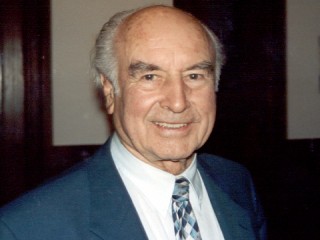
Hofmann, Albert biography
Date of birth : 1906-01-11
Date of death : 2008-04-29
Birthplace : Baden, Switzerland
Nationality : Swiss
Category : Science and Technology
Last modified : 2010-04-16
Credited as : Swiss scientist, Lysergic acid diethylamide-LSD,
0 votes so far
Hofmann was born in Baden, Switzerland, the first of four children born to factory toolmaker Adolf Hofmann and his wife Elisabeth (born Elisabeth Schenk). Because of his father's low income, Albert's godfather paid for his education. When his father fell ill, Hofmann took up a position as a commercial apprentice in concurrence with his studies. At the age of twenty, Hofmann began his chemistry degree at the University of Zürich, finishing three years later, in 1929. His main interest was the chemistry of plants and animals, and he later conducted important research regarding the chemical structure of the common animal substance chitin, for which he received his doctorate, with distinction, in 1930.
Hofmann joined the pharmaceutical-chemical department of Sandoz Laboratories (now Novartis), located in Basel as a co-worker with professor Arthur Stoll, founder and director of the pharmaceutical department. He began studying the medicinal plant squill and the fungus ergot as part of a program to purify and synthesize active constituents for use as pharmaceuticals. His main contribution was to elucidate the chemical structure of the common nucleus of Scilla glycosides (an active principal of Mediterranean Squill). While researching lysergic acid derivatives, Hofmann first synthesized LSD on November 16, 1938. The main intention of the synthesis was to obtain a respiratory and circulatory stimulant (an analeptic). It was set aside for five years, until April 16, 1943, when Hofmann decided to take another look at it. While re-synthesizing LSD, he accidentally absorbed a small quantity through his fingertips and serendipitously discovered its powerful effects.
Hofmann became director of the natural products department at Sandoz and went on studying hallucinogenic substances found in Mexican mushrooms and other plants used by the aboriginal people. This led to the synthesis of psilocybin, the active agent of many "magic mushrooms." Hofmann also became interested in the seeds of the Mexican morning glory species Rivea corymbosa, the seeds of which are called Ololiuhqui by the natives. He was surprised to find the active compound of Ololiuhqui, ergine (lysergic acid amide), to be closely related to LSD.
In 1962, he and his wife Anita traveled to southern Mexico to search for the plant "Ska Maria Pastora" (Leaves of Mary the Shepherdess), later known as Salvia divinorum. He was able to obtain samples of this plant but never succeeded in identifying its active compound which has since been identified as the diterpenoid Salvinorin A.
In 1963, Hofmann attended the annual convention of the World Academy of Arts and Sciences (WAAS) in Stockholm.
Hofmann called LSD "medicine for the soul" and was frustrated by the worldwide prohibition that has pushed it underground. "It was used very successfully for 10 years in psychoanalysis," he said, adding that the drug was hijacked by the youth movement of the 1960s and then unfairly demonized by the establishment that the movement opposed. He conceded that LSD can be dangerous in the wrong hands.
In December 2007, Swiss medical authorities permitted a psychotherapist to perform psychotherapeutic experiments with patients who suffer from terminal stage cancer and other deadly diseases. Although not yet started, these experiments will represent the first study of the therapeutic effects of LSD on humans in 35 years, as other studies have focused on the drug's effects on consciousness and body. Hofmann supported the study, and continued to believe in the therapeutic benefits of LSD.
Hofmann was due to speak at the World Psychedelic Forum from March 21 to March 24, 2008, but was forced to pull out because of poor health.
Hofmann died of natural causes on April 29, 2008, in the village of Burg im Leimental, near Basel, Switzerland. He was 102 years old.
















